“My guitar playing sails under the radar, and I quite like that”: Public Service Broadcasting’s J. Willgoose, Esq
The guitarist and band leader on why he’d hate to be called a pedal collector, cutting loose for the first time on record, and the €20 flea market instrument that became a huge part of Public Service Broadcasting’s new record, Bright Magic.

Image: Alex Lake
You won’t read this in many self-help books, but sometimes the best thing you can do in life is to give up. That’s what J. Willgoose, Esq – the dapper, bespectacled creative force behind electronic rock outfit Public Service Broadcasting – did in around 2009, and it turned out to be the best decision he ever made.
“I stopped trying to be an average guitarist in an indie band, because I’d tried that lots of times and failed!” Willgoose reveals, chuckling. “I was just doing stuff for my own amusement really. I was approaching 30 so I just thought, it’s not going to happen now, I may as well just do something that’s fun and if I do need to drag my mates to the pub to watch it, then it may as well be something that’s quite fun for them to watch as well y’know?”
These aims would coalesce into the fledgling Public Service Broadcasting – a band that melded synths, electronic beats and Willgoose’s proggy guitar with snippets from old public information films, telling stories through the music that sought to, as neatly summed up in PSB’s debut album title – Inform. Educate. Entertain.
Since that first album in 2013, Willgoose has been joined by fellow multi-instrumentalists Wrigglesworth and JF Abraham, in creating a series of concept albums and EPs that cover everything from the Space Race to the death of South Wales’ coal industry. But for the band’s fourth full-length, Bright Magic, Willgoose’s muse drew him in a different direction – he was going to write an album about Berlin.
“I didn’t really know why I wanted to write an album about Berlin,” he admits. “I just felt this draw to it, kind of like a magnet really. Something about Berlin is just really, really cool. So I think writing the record was just kind of like, ‘How has this city achieved that status in my head, and millions of heads around the world?’ What is it about the city itself? What is it about the people who’ve been there and built their myths around it, like Bowie and Dietrich? And in answering those questions, the record started to write itself.”

Let there be light
As with 2017’s Every Valley, where Willgoose embedded in Ebbw Vale Miner’s Institute to create the record, here he decamped, pre-pandemic, to Berlin, and to that city’s most evocative musical touchstone – Hansa. From Bowie and Iggy Pop to U2 and Depeche Mode, the famous studio has played a huge role in the musical history of the city, and spending nine months writing there wasn’t without its challenges…
“It was definitely a place where, if you were looking for a good taste of imposter syndrome, it was available freely, pretty much every day as you walked through the doors!” Willgoose reflects. “You’re putting yourself in that situation and it’s just not possible to achieve anything like what those people – especially Bowie and Visconti – achieved in that building. So it was a little bit fraught – I don’t find writing very fun, or very easy… maybe it’s not supposed to be. I’m always a little bit harsh on myself anyway, but I think being in a foreign city without my usual support network of friends and family around me, I think it was a little bit more bruising. Maybe that’s a good thing! Maybe it was totally unnecessary. And just a world of pain that I inflicted on myself for no good reason! But we’ll never know.”
Bright Magic is a very different record for Public Service Broadcasting, and one where Willgoose embraced the guitar as a more esoteric instrument, as the electronic sounds that have long formed Berlin’s heartbeat naturally took more of a starring role.
“I would hate to be called a collector. You shouldn’t buy things to collect them, you should buy them to play”
“I think that kind of synth-y sound was washing around in my head anyway, so the guitars are being used a bit more texturally,” he says. “A lot of the drones that you hear, a lot of the washes of sound start out on the guitar, and they’re built up with little loops, or little pitch-shifted bits or phasers.
“On stuff like, Gib Mir Das Licht all the paddy sounds that run through it, it’s all guitars. It’d be really interesting to be able to go through the album and be like, ‘This is a guitar, this is a guitar, this is a guitar…’ Because it’s stuff that you wouldn’t necessarily think it was. It’s adding textural body to it, and a bit of expression and depth, which I’m probably more competent at creating with a guitar.
“But it’s so funny, there are so many layers to so much of it, and a track like People, Let’s Dance! was genuinely ridiculous – it ended up with about 250 tracks on that project! But it suffered when I took stuff out. I do this thing when I’m writing and mixing, I mute stuff and I go, ‘Is it better with, or is it better without?’ And it was so strange, because everything was doing something really important. If you took any particular element out, it lost something. Which in such a densely layered piece, felt very unusual to me. And I think maybe, that speaks to how important the guitar as a textural instrument is to the record.”

In the know
Despite guitar being less of an overt presence for much of Bright Magic, when it comes to the fore, it does so in force, such as on standout Der Rhythmus der Maschinen which sees Willgoose, in his words, “kinda trying to sound like St Vincent… and just really letting rip for once”. It’s not something that we’ve seen much of on previous PSB records.
“There’s not too many times where I’ve done that in our stuff,” he agrees. “It just felt nice to have a little bit of ‘horns in the air’ nonsense I suppose. I’ve done it before on some demos, but I always take it out, because anything that sounds a bit showy to me, I’m just instantly suspicious of. I quite like to go a bit under the radar as a guitar player.”
Going under the radar is something of an antithesis to what most guitar players want to do when they strap on a guitar, but for Willgoose it’s always been the goal.
“The focus of this show is often elsewhere,” he explains. “It’s either on the visual elements or the lights or, y’know, Wrigglesworth is an incredible performer and drummer, and JF Abraham is so much more kinetic on stage than the rest of us are. So, there’s a lot of things taking attention away from me, which I really appreciate! It’s been designed that way. It’s not an ego trip, so I quite enjoy that, and I can just get on with it.
“Anything that sounds a bit showy I’m instantly suspicious of. I like to go under the radar as a guitarist”
That being said, while he doesn’t hog the limelight with his guitar playing, Willgoose appreciates when his peers notice what he’s trying to do…
“I remember when we toured, The Race for Space, we had Smoke Fairies with us – they’re both good guitar players but I particularly love Katherine [Blamire]’s guitar playing,” he recalls. “By the time we got to the London gig on that tour, she snuck up alongside me and went, ‘You’re actually a good guitarist, aren’t you? A lot of the stuff you’re doing is really hard, but you’re not making a big deal out of it…’ And I was like, ‘That is exactly what I want to hear. Thank you very much.’
“There is a level of skill and technical proficiency to it, but it’s not too, ‘I want everyone paying attention to me’, because that couldn’t be further from the truth. So it’s technically quite difficult, but I think it does sail a bit under the radar, and I do quite like that, to be honest. Then when your peers recognise it, that is truly lovely.”

Rolling with it
Given Public Service Broadcasting’s very leftfield approach to creating music, you’d be forgiven for assuming that Willgoose’s guitar background was as esoteric as the influences his band pull in, but the real answer is much more relatable.
“I remember Noel Gallagher being on the cover of a magazine about 10 years ago saying, ‘I’m the reason you play the guitar’. I thought, ‘Well actually, fair enough – you’re right on that one!’” Willgoose explains. “It was Oasis. It’s easy to look back on them now and think like what a bunch of plodding, middle of the road stuff it turned out to be. But that first record was so exciting when it came out, and it has that on the edge, loud guitar music element to it. It was just so exciting. I think I was about 13 or 14 and it was the perfect time to hear it. And they were quite easy songs to learn as well, so it was a really good way to get into it. I got the Squier guitar pack from the local guitar shop for Christmas and that was me off really.
“From there I moved through some of the more complicated stuff that was around at the time – I started trying to learn some of Jonny Greenwood’s stuff, and then Ed O’Brien’s stuff… and Thom Yorke’s stuff as well, which isn’t easy. And then it was the Manics, and James Dean Bradfield’s parts which are like, ‘Oh god, this is… this is very difficult!’ Try playing the chord progression from Design For Life, cleanly! It’s not a big showy part but try to move from the third chord in that progression to the fourth without hitting some horrible buzz or something – it’s not easy!”

Everyone remembers when they first got a proper guitar, and for Willgoose, there were two instruments that made him feel like he had made a giant leap, both of which still play an important part in PSB today.
“I got a Japanese Jaguar when I was in my late teens,” he says. “I’d never played one, I just thought it looked like the coolest thing ever, and I still do, to be honest! They’re just amazing looking guitars, and I still use it. It’s been through various set-ups and iterations and stuff, and now it’s very similar to the Johnny Marr Signature – very simplified and it’s got Bare Knuckle pickups in it, which sound great.
“Then I went abroad to America for a summer to work when I was at university, and I saved up enough money there to buy a Rickenbacker 330 – that was the one. I remember buying that, and in the little leaflet it comes with it says, ‘Congratulations, you now own a world-class musical instrument’ and I think that was the first time it felt like, ‘Oh no, yeah, it feels like I do’. It doesn’t get quite as much love these days, my Ricky, but it’s on every record, and it’s all over the first record in particular. More guitars need 24 frets – that’s the thing!”

Fill the gaps
As PSB’s music has evolved, so has Willgoose’s guitar stable – with the guitarist placing great value on being able to cover as many bases as possible both live and in the studio.
“I was talking with Editor’s guitar tech when we were on the road with them, and we agreed that the sound of real maturity as a guitar player was coming to love and use the Strat more,” he explains. “That definitely has happened in the last few years. I think John Squire said playing a Strat on stage was like wearing a tie or something. It just felt too stiff and formal.
“But after a while, you start to recognise that there’s a reason so many of the greats played them. And they’re so versatile, and so many of the sounds that you get from it, you can try and fake on other guitars, but you can’t, you can’t really get that out-of-phase sort of sound any other way, it just doesn’t sound the same.”
“It sounds weird to be influenced by a YouTube channel for a record but I think it was definitely the case”
This desire to fill in the gaps in his sonic arsenal also led to the creation of the most unique guitar in Willgoose’s collection – a P-90 loaded single-cut signature model with a Jazzmaster vibrato made by Cambridge’s Fidelity Guitars.
“Matt [Oram] got in touch out of the blue and just said, ‘I make these guitars, what do you think, would you like one?’ And that’s always a good way to get my attention!” Willgoose tells us about the birth of his partnership with one of the UK’s coolest new guitar brands.
“I think that guitar for me was almost about filling in some of the few gaps that I have in my guitar collection. So, I didn’t have any P-90 stuff at the time, but it was also coming along at a time, and I was trying to find an interesting, new sound. So, it wasn’t created with anything specific in mind and it wasn’t even necessarily created to match the way that I play or to be like. ‘If you wanna sound like me, get this guitar!’ That’s not what the purpose of the guitar was.

“And so then because it had a new, different sound, it ended up being the main guitar on the White Star Liner EP, and I think it’s influenced the way that record was written, just because new guitars always do.
“I don’t think I used the signature the new record, because the room I had in Hansa, it’s great building and everything, amazing history… but terrible electrical problems! And playing with P-90s in that was just a recipe for the loudest hum you’ve ever heard. I tried it on a couple of tracks and it sounded great, but the hum was unusable. So it was quietly and regrettably put to the back of the queue.”
Far from being a one-time deal, however, the relationship between Willgoose and Fidelity is evolving all the time, and phase two might be on the horizon.
“I don’t want to jump the gun, but for this record I got a custom Stellarosa, and I think he’s talking about making that a new signature model and quietly retiring the old one,” he reveals. “The set-up that I’ve got for that Stellarosa, I love it. That’s a really versatile and cool guitar as well – when we’re in the studio, it really came into its own in that environment because it just sounded so great on so many things.”

Pedal power
Looking at the shots of PSB in the studio, it’s hard not to notice the abundance of high-end boutique pedals strewn across the floor – 1981 Inventions, Jackson Audio, Earthquaker, Land Devices, Hudson Electronics… it’s clear that Willgoose is a ‘pedal guy’, but one thing he’s definitely not, is a pedal collector.
“No!” he exclaims when we pose the question. “If that’s your thing, fine, but I would hate to be called a ‘collector’. You shouldn’t buy things to collect them, you should buy them to play them! And I’m pretty good at selling the stuff I don’t use now. Collecting stuff depresses me. It’s more about just the creative inspiration you get from, well… it’s buying new toys basically, isn’t it? You’re trying to create that playful atmosphere, and they do help. Y’know, I have to do a good job of explaining that sometimes for certain members of my household… but they do inspire creativity!”
Interestingly, Willgoose’s pedal obsession has been fuelled by a very relatable source – the explosion of diverse and interesting YouTubers who have helped foster the current golden age of stomppoxes.
“For years the only pedal demos you could find were just blues lawyer-types riffing over stuff,” he says of the bad old days. “You’re like, ‘Ugh, you’ve got the drive always set to maximum! I don’t wanna hear the maximum I want to hear it break up cuz that’s what I’m after!’ It was a torturous experience trying to find out what a pedal sounds like before you bought one.
“But now there’s just so many artful people, and I think the Knobs Channel is the one that really set the bar so high, and it led to me buying a load of stuff before realising, it’s not the stuff. It’s him. A lot of the more interesting sounds on the record probably came from trying to copy some of the techniques from that channel I think. He’s got a very distinct way of playing that I don’t get anywhere near but certainly, his general approach is what I try to take on board with making these more textural sounds. It sounds weird to be influenced by a YouTube channel for a record, but I think it was definitely the case.”

String theory
Pedals aside, Willgoose also explored more unconventional avenues to created Bright Magic’s dense, layered sonic palette. On the one hand the album features the sound of various different lightbulbs that were hit or smashed and then fed through harmonizers and snyths to create various sounds, with the smashed shard then turned into imptomptu shakers. And then on the other hand you had the kantele – a Finnish folk instrument that Willgoose picked up at Berlin flea market and ended up being an important sonic addition to the record.
“I was going around the free markets in Berlin, and I was actually looking for old lightbulbs, because I’m an interesting guy!” he jokes. “But then I was somewhere in Prenzlauer – the famous flea market – this guy had a few stringed instruments there for sale, and this one was actually made in, Berlin, which is strange because it’s a Finnish folk instrument. There was obviously a demand for them in Berlin for them to be made there!
“I don’t know if it’s a particularly fine example of the Kantele or not, and I’m almost certainly not playing it right, but I was looking for something like Moss Garden on Heroes, where Bowie uses a koto – that very otherworldly plucked sound. And this gave me an element of that. It’s doubling a lot of the synth parts and it’s doubling some of the piano in some instances. It just gives you that really bright attack, but because the notes ring out as well you get really interesting resonances.”
It’s a far cry from boutique pedals or fancy synthesisers that made up the rest of the album, but given its contribution to the record, it was clearly a bargain. Well, maybe.
“It’s probably the best 20 euros I ever spent!” Willgoose concludes. “I was ready for him to try and rip me off, because my German wasn’t great and I obviously looked like I didn’t know what I was talking about. Actually, maybe I did get ripped off. Maybe it’s a piece of crap and it’s only worth two euros! Still, it’s on the record!”
Bright Magic is out September 24 on PIAS.
